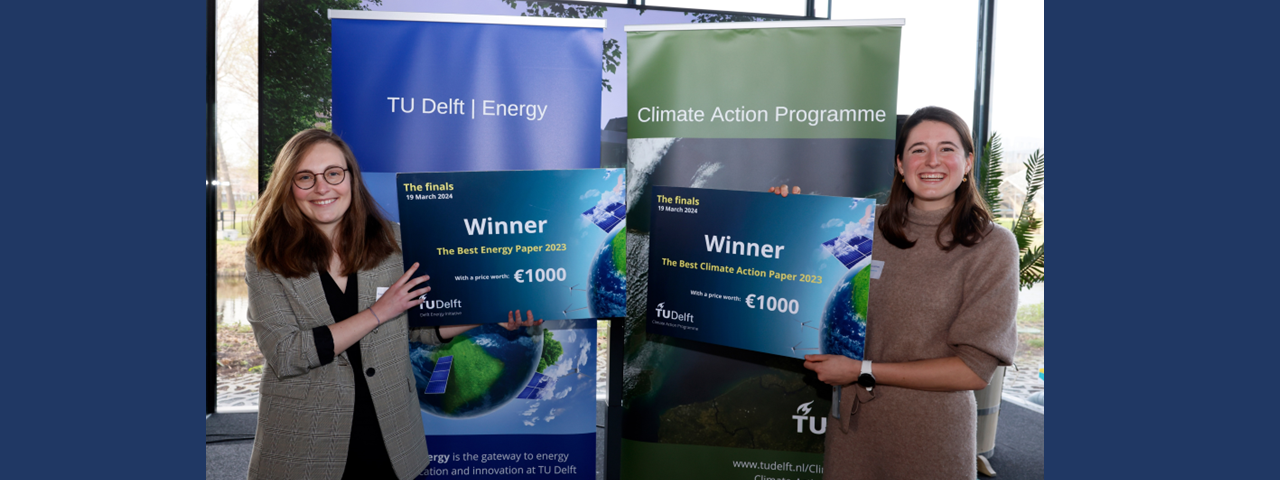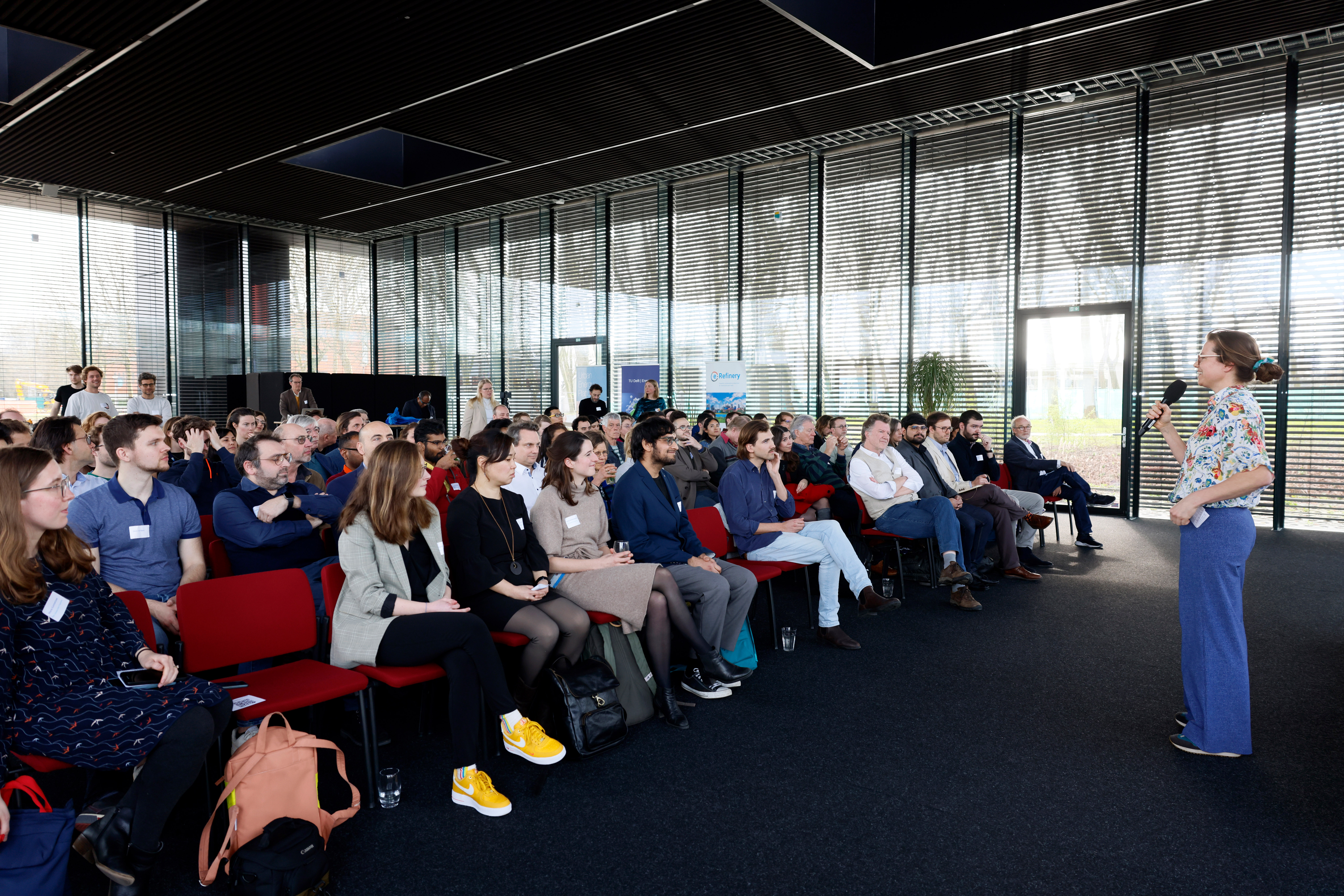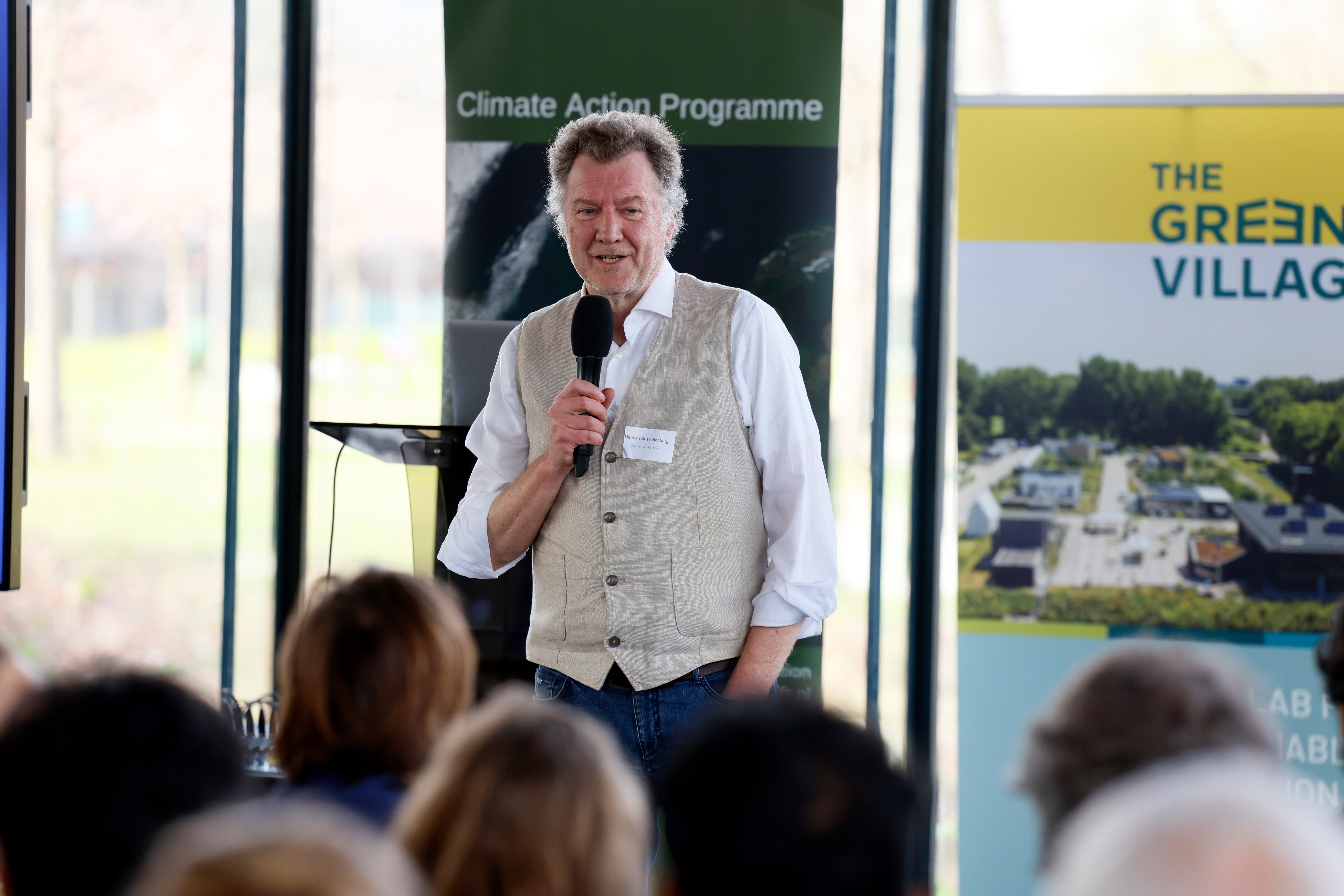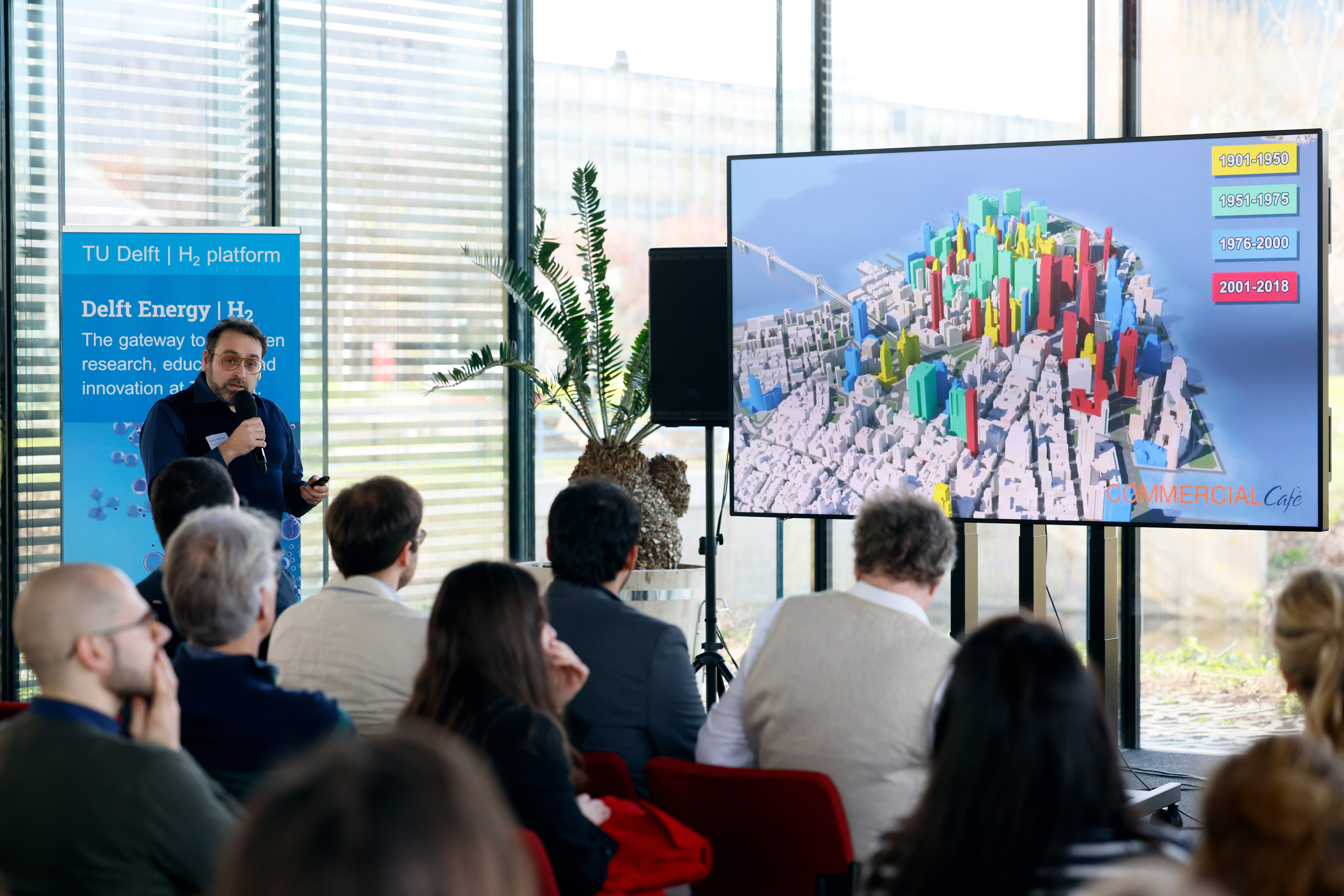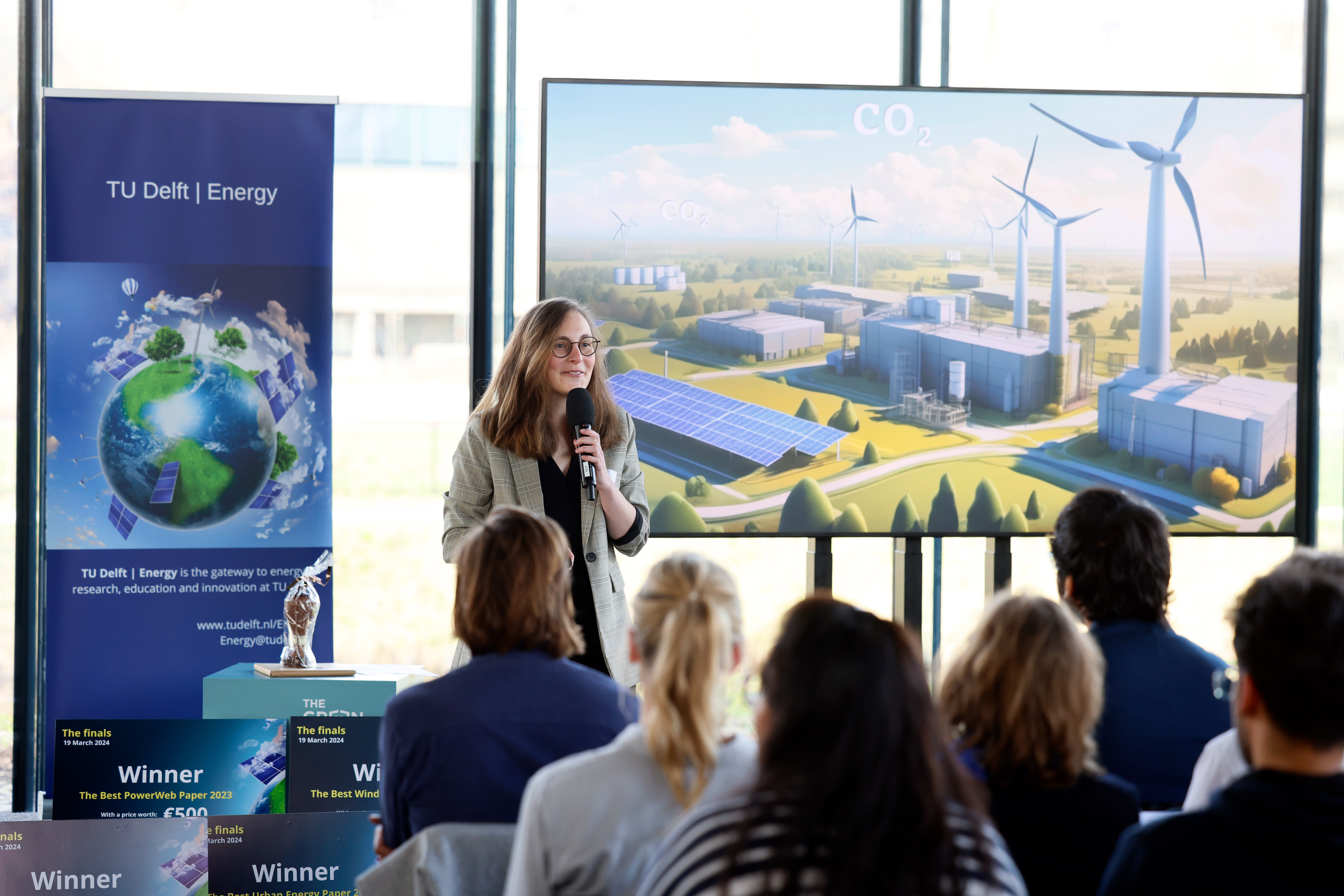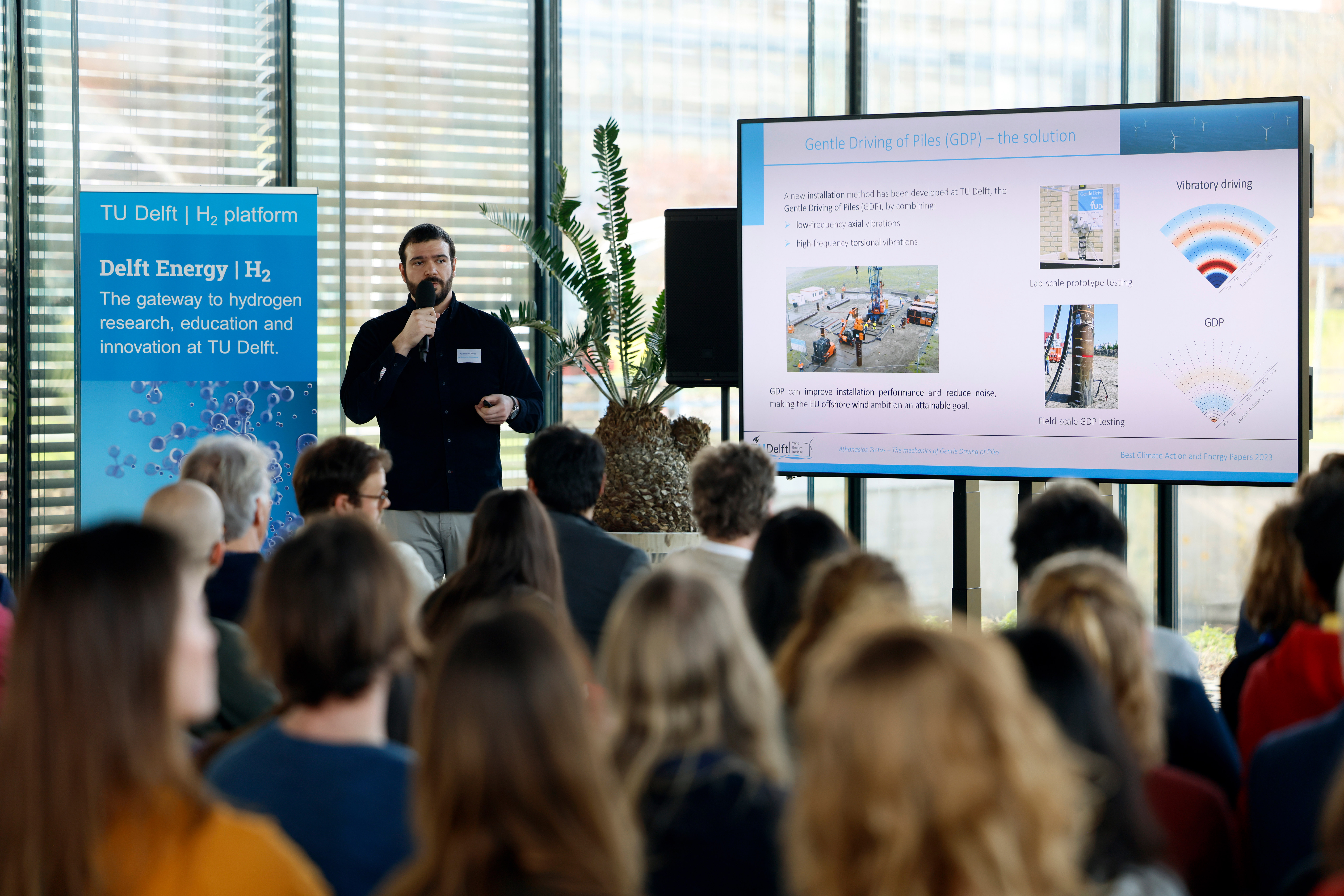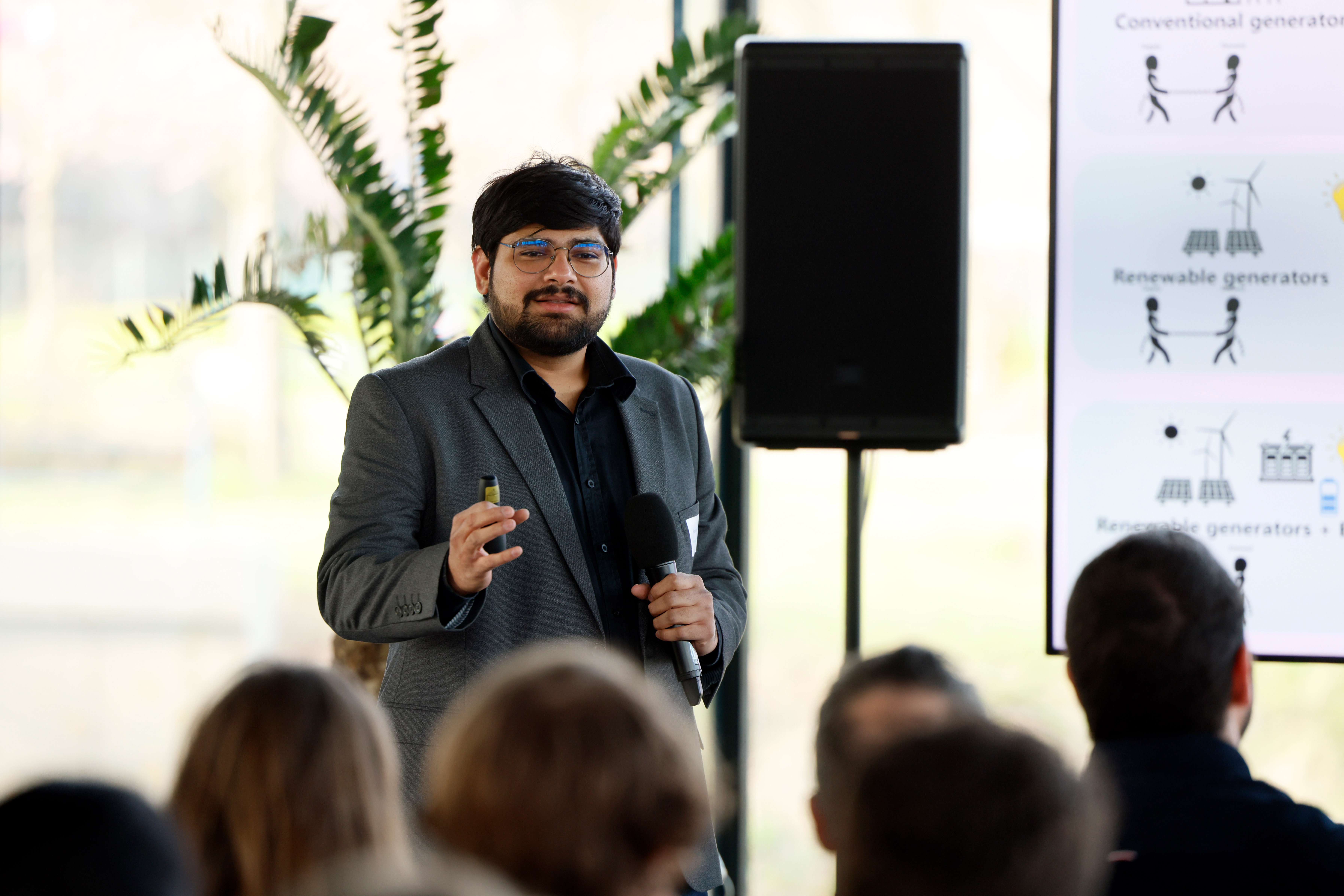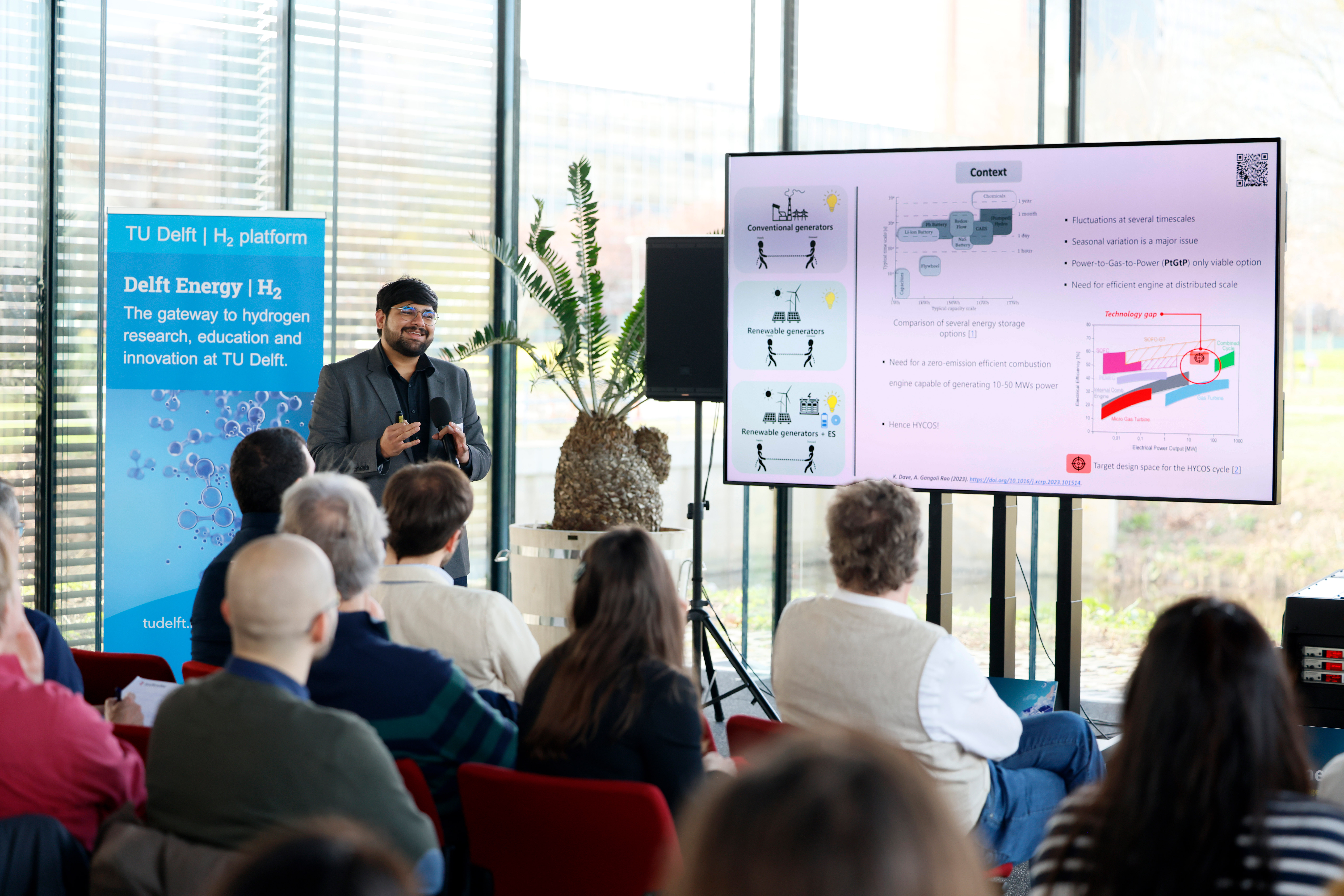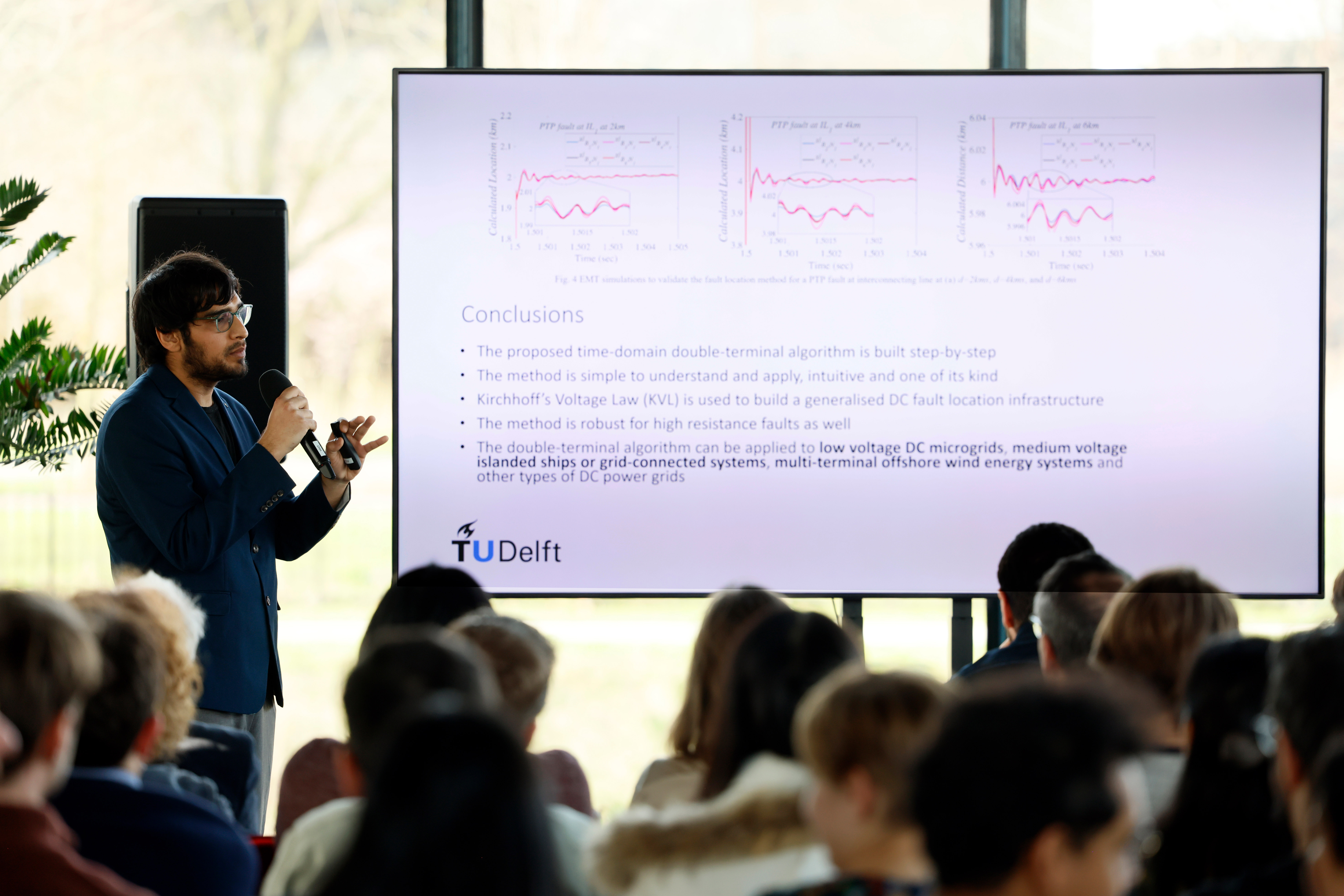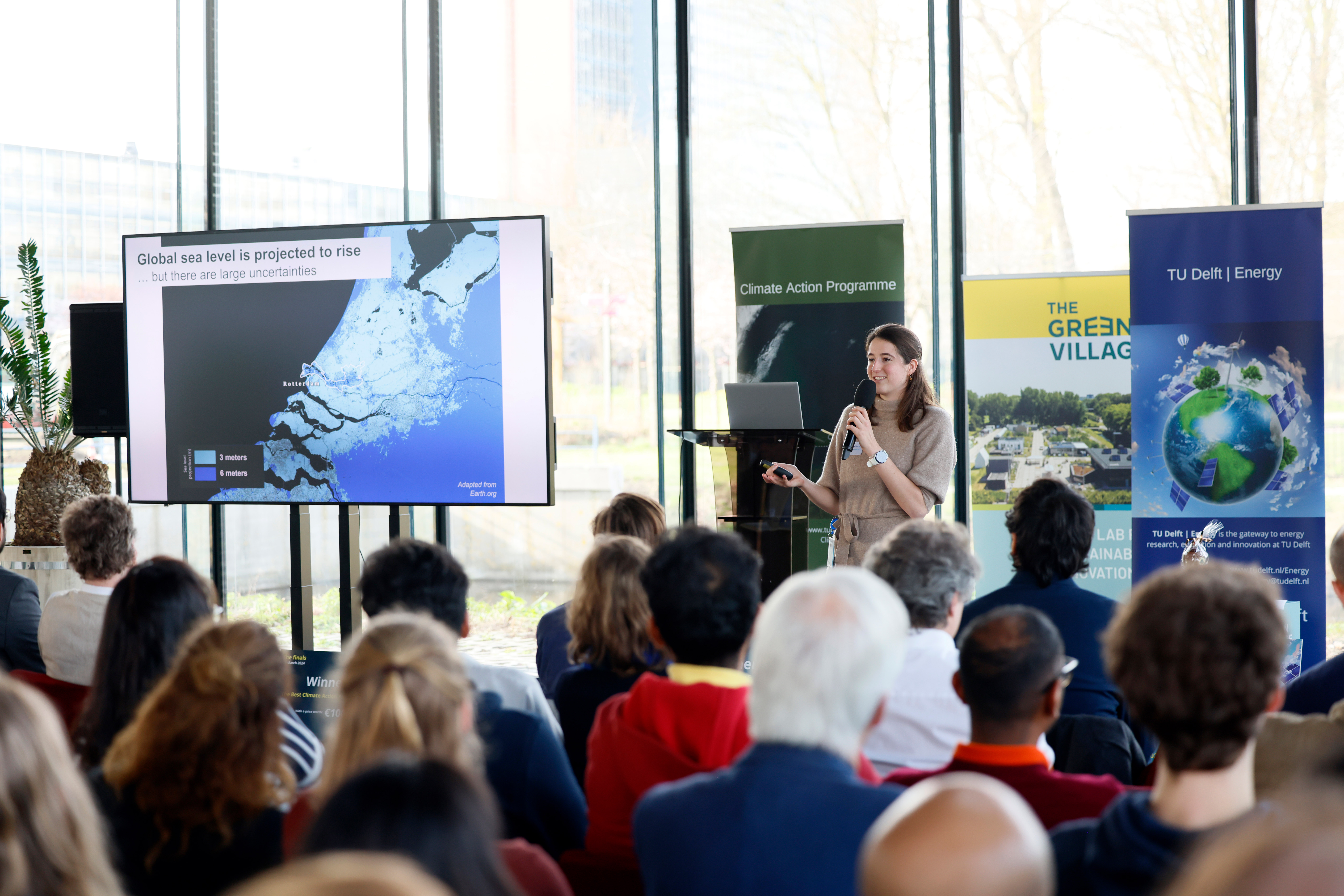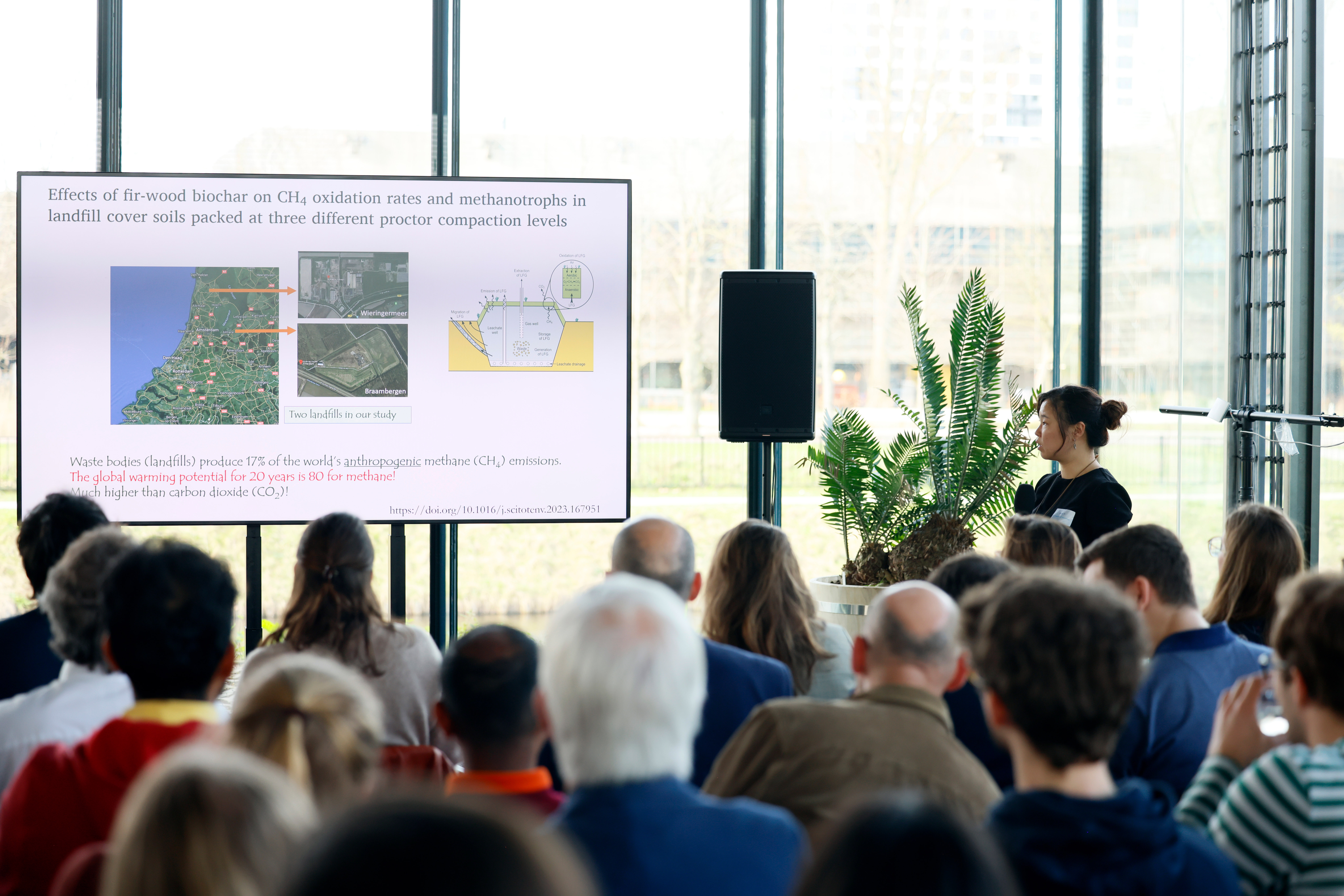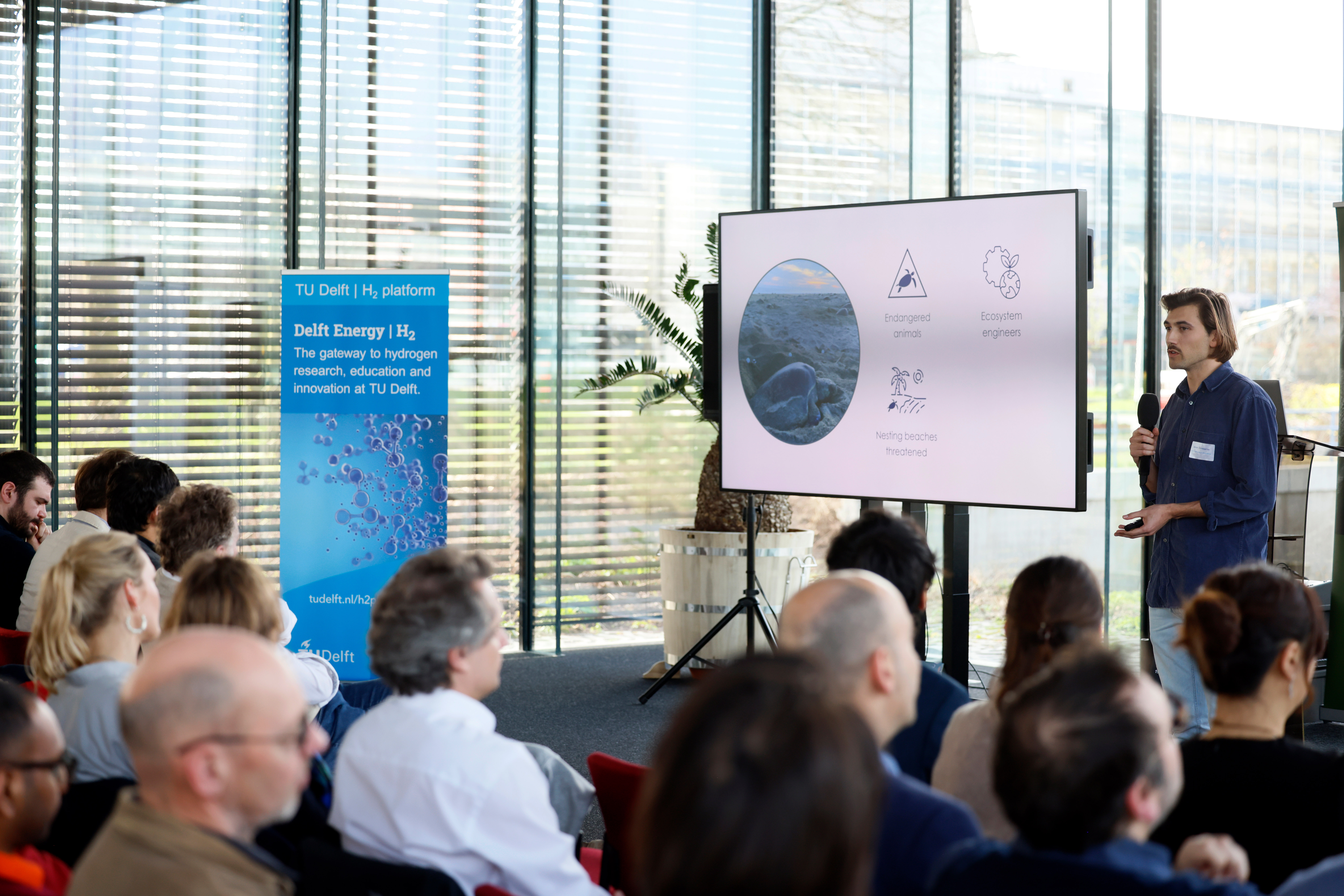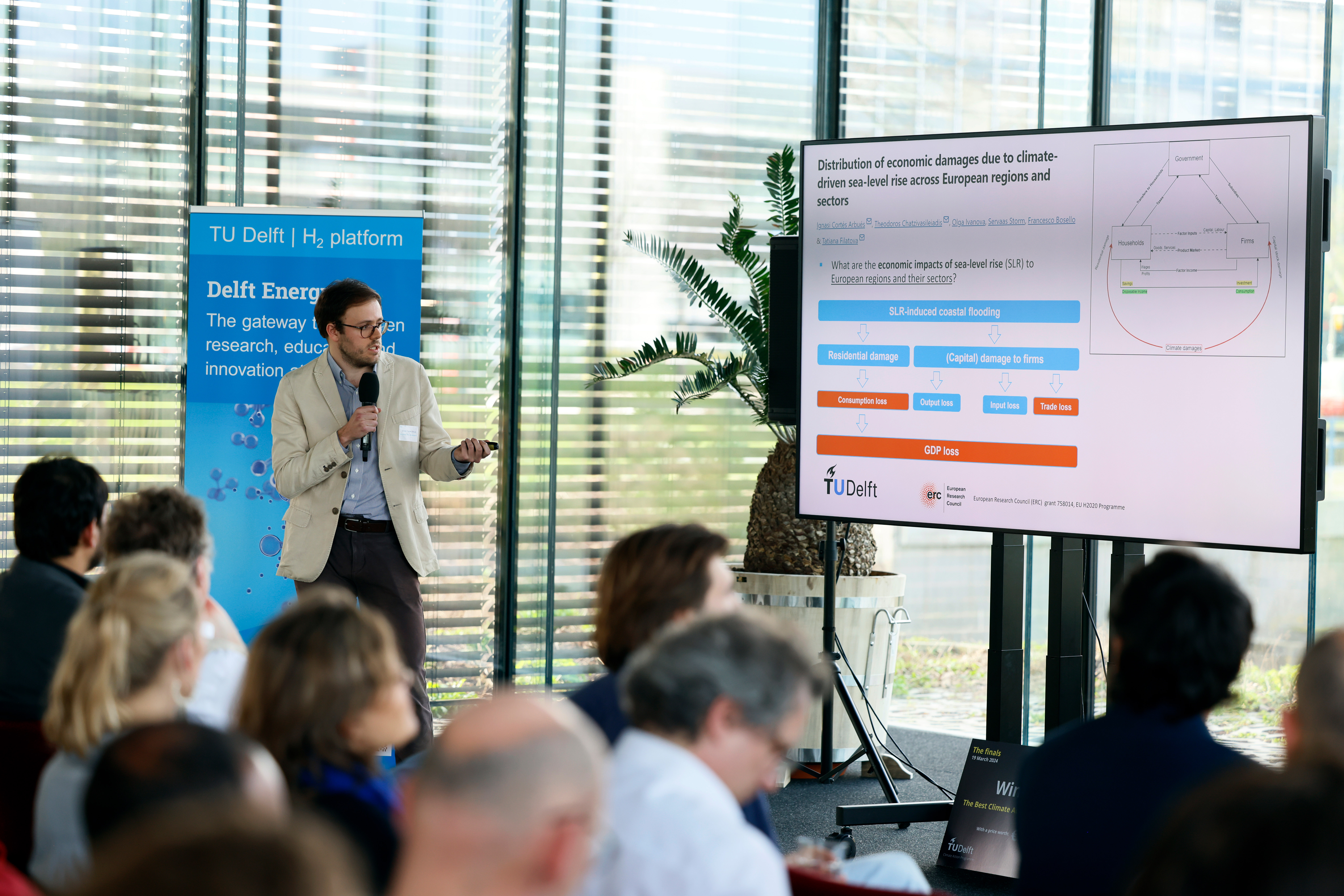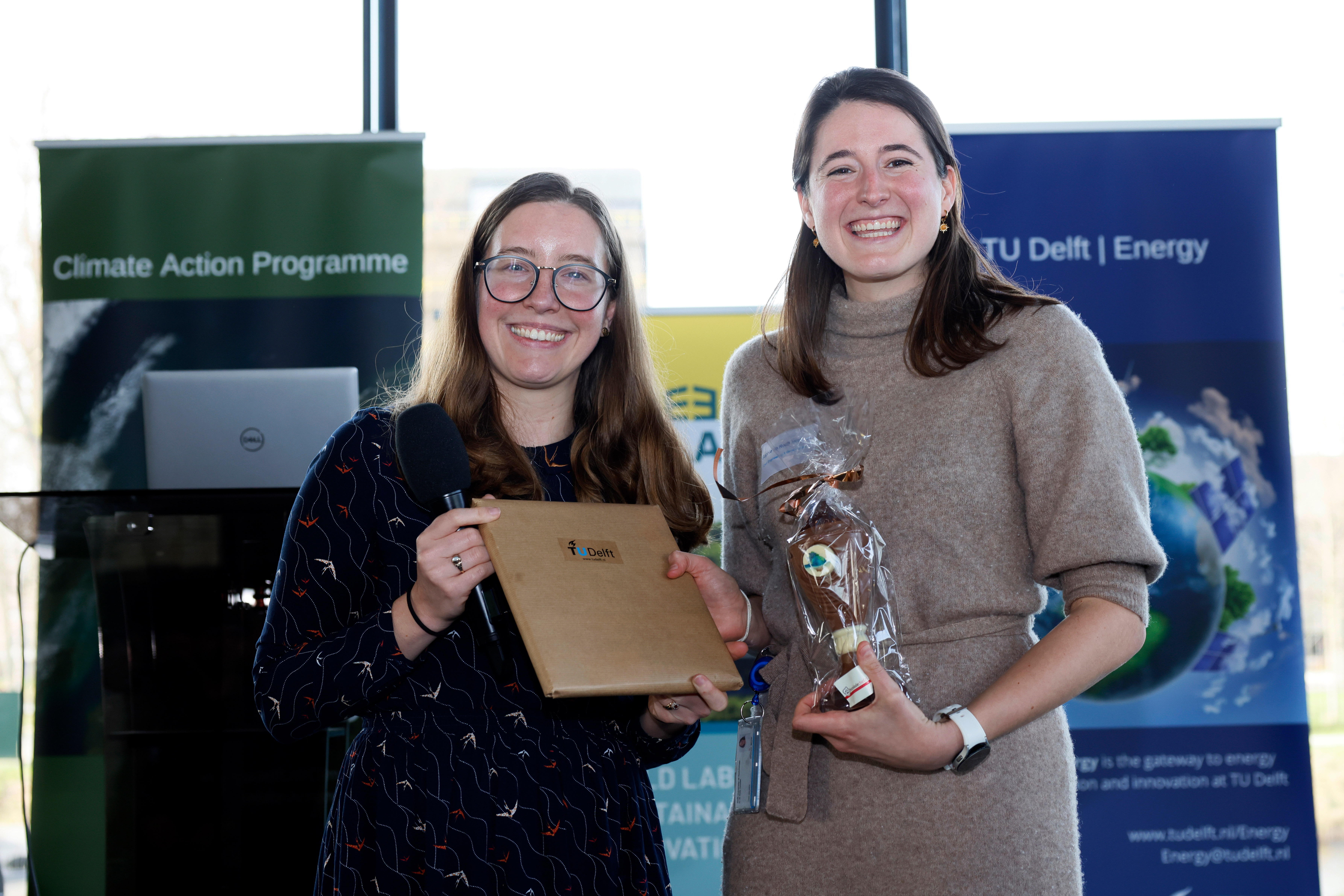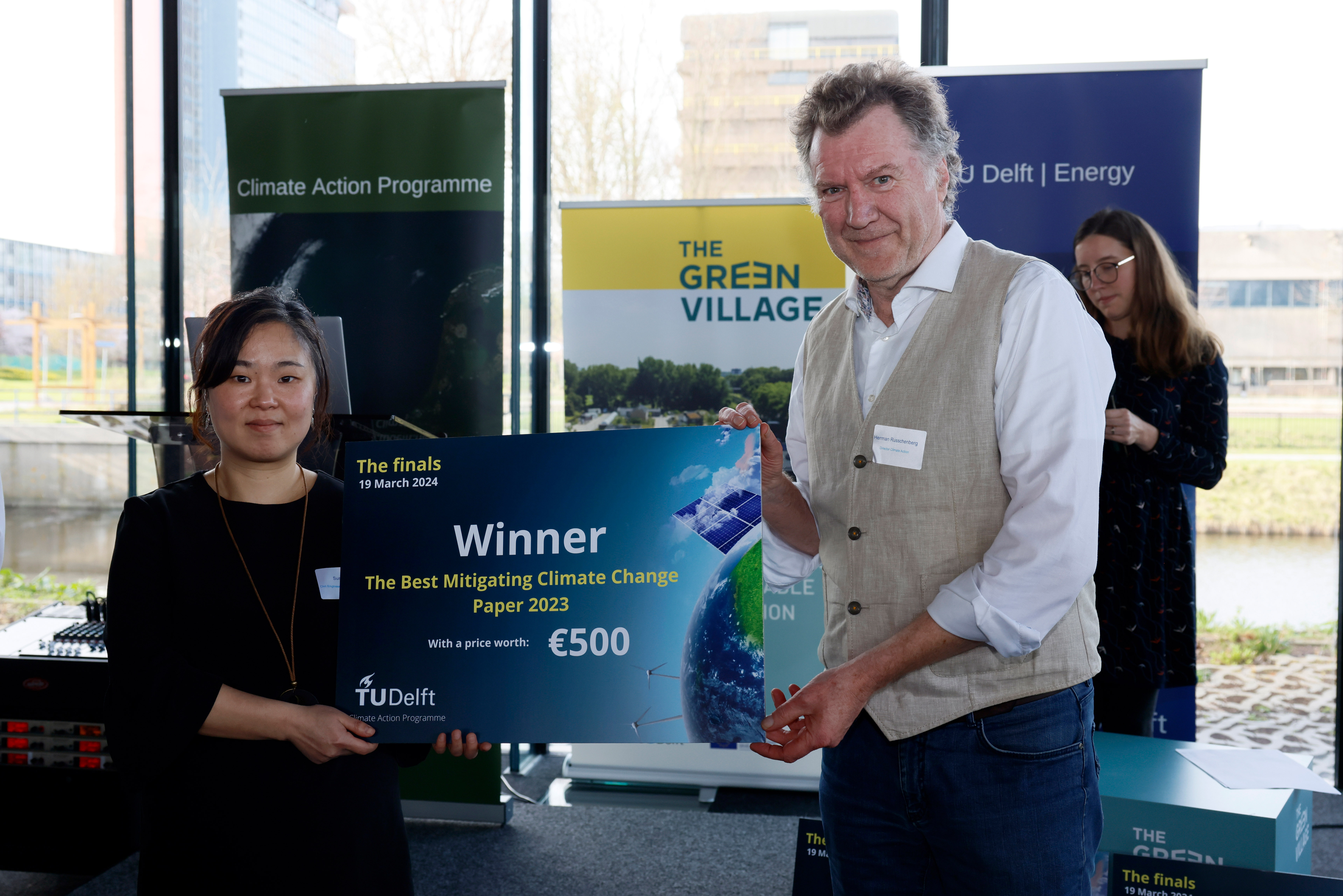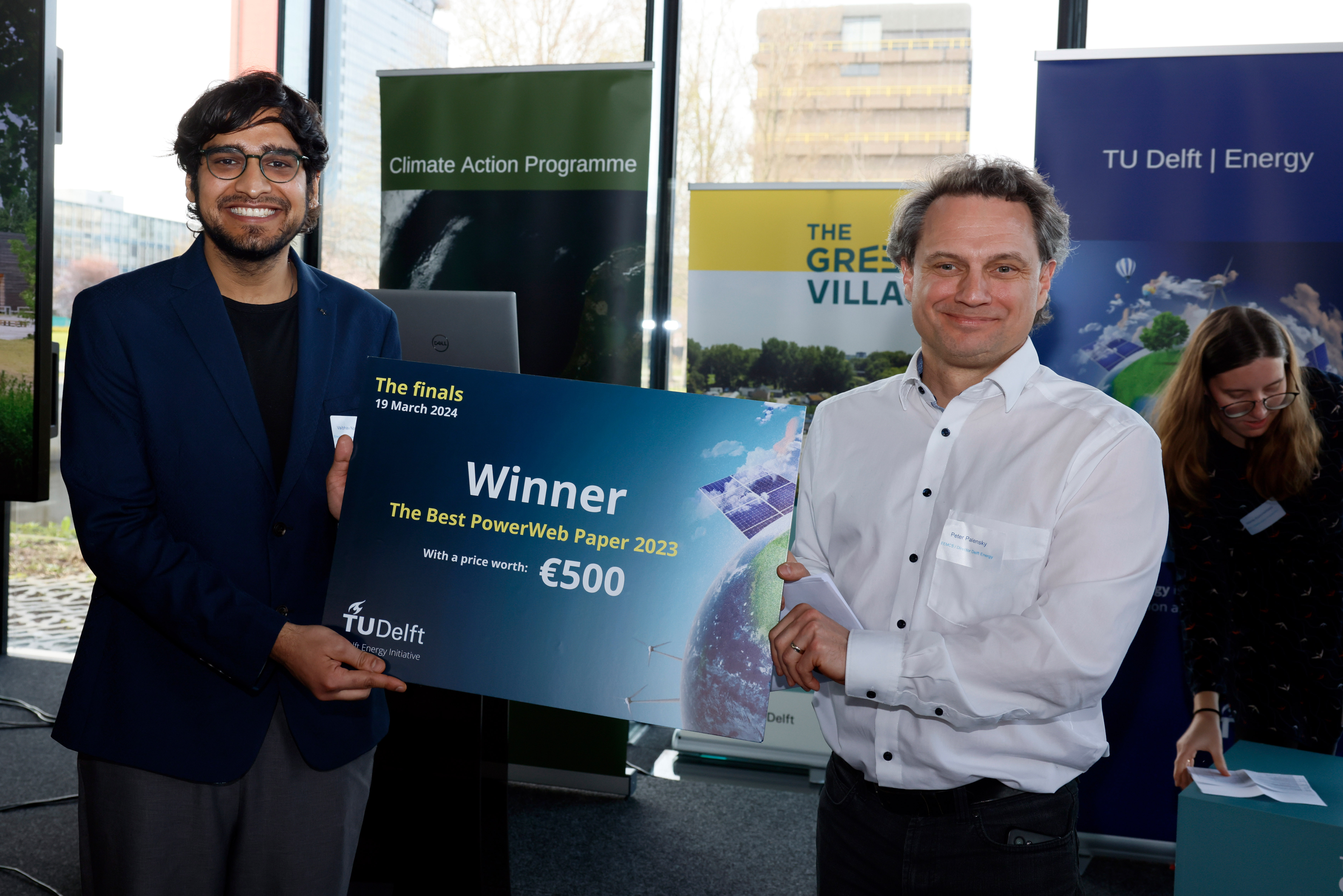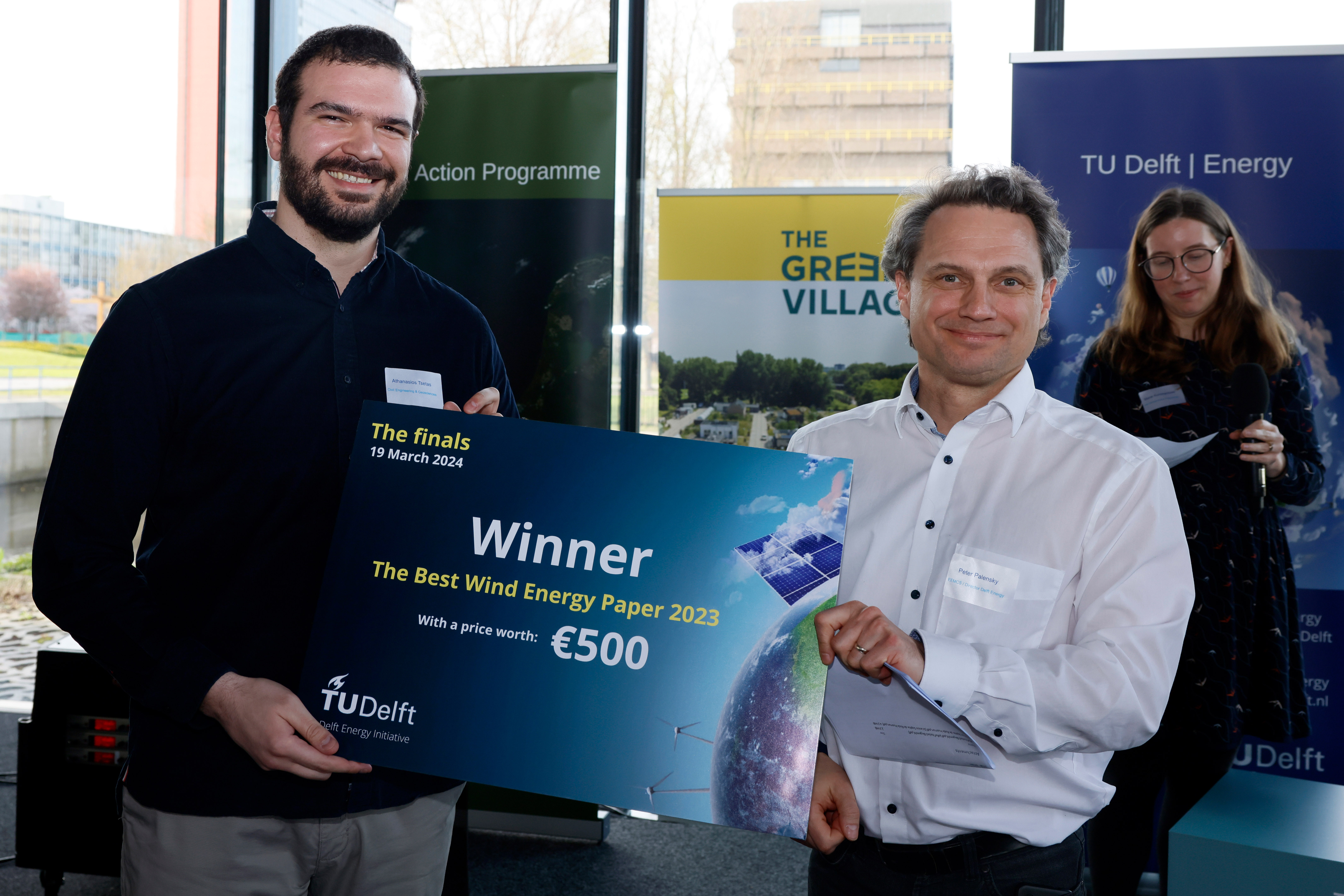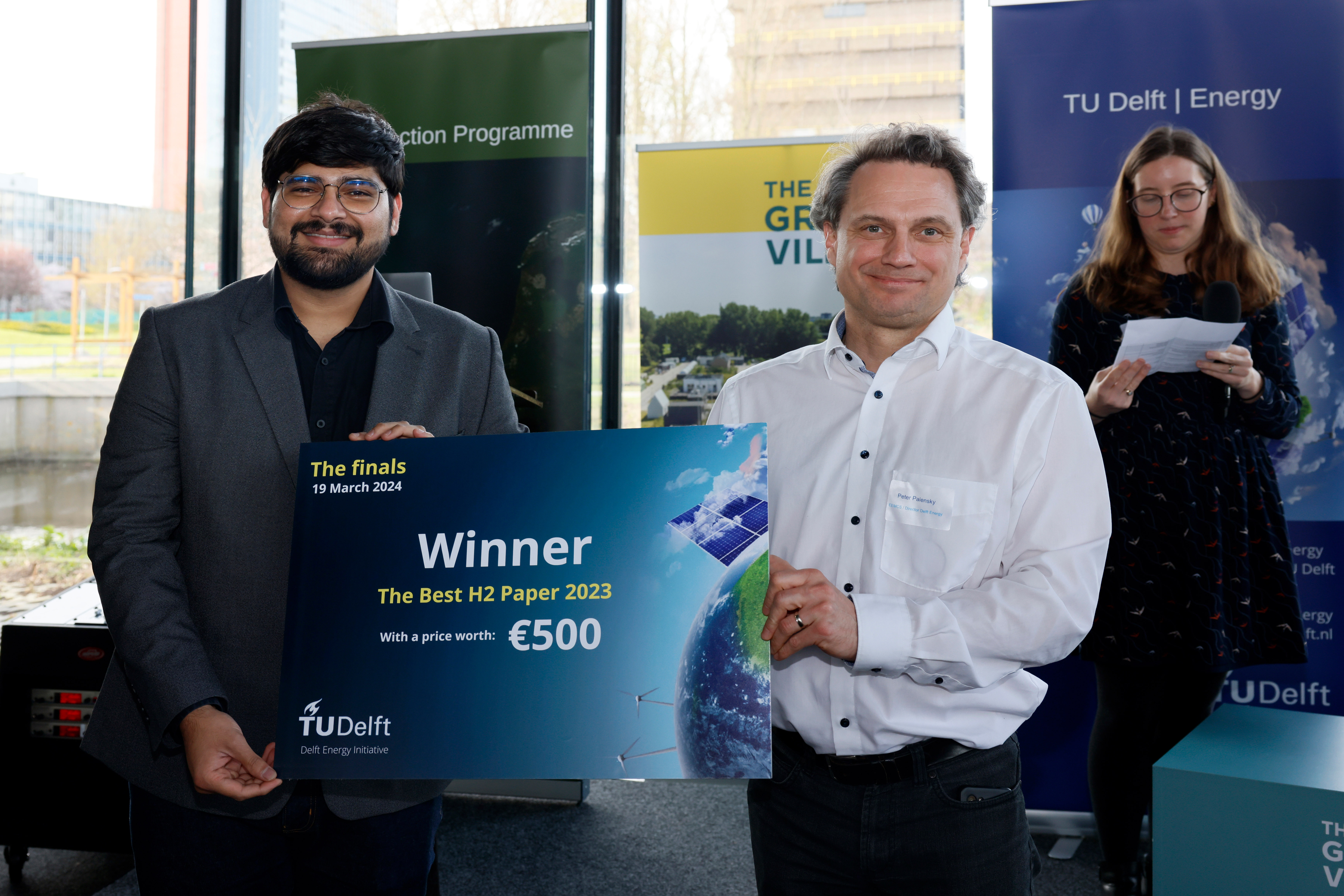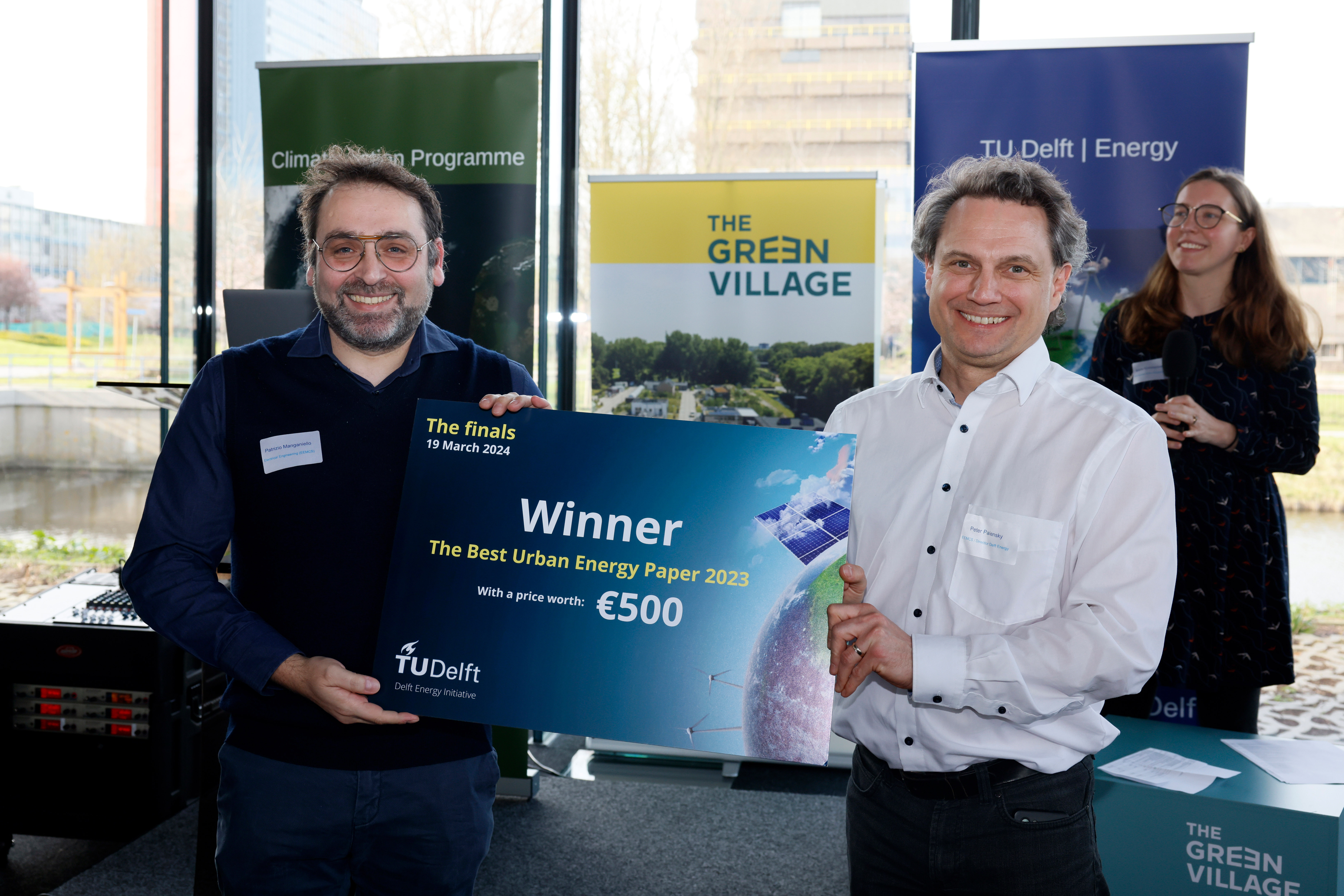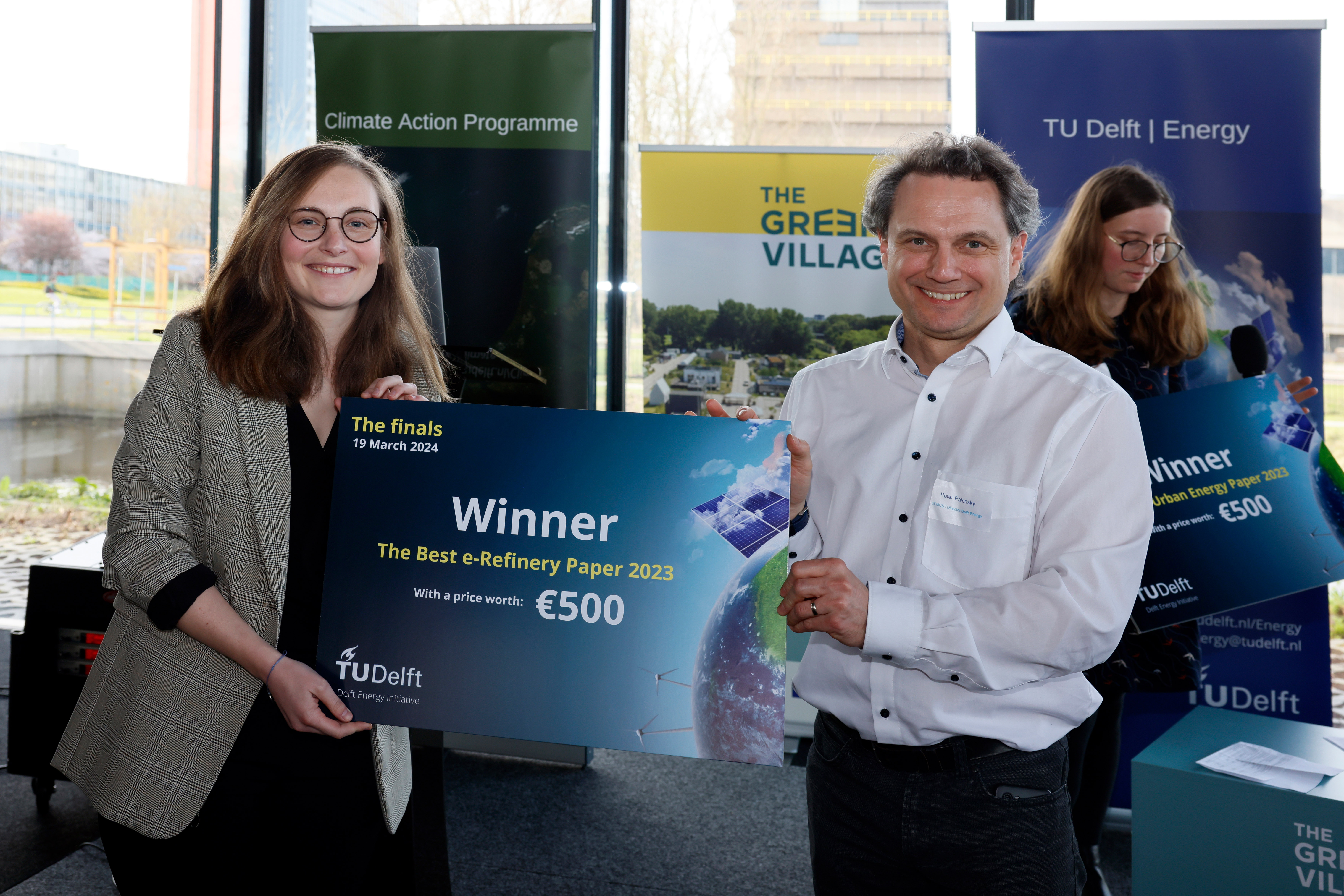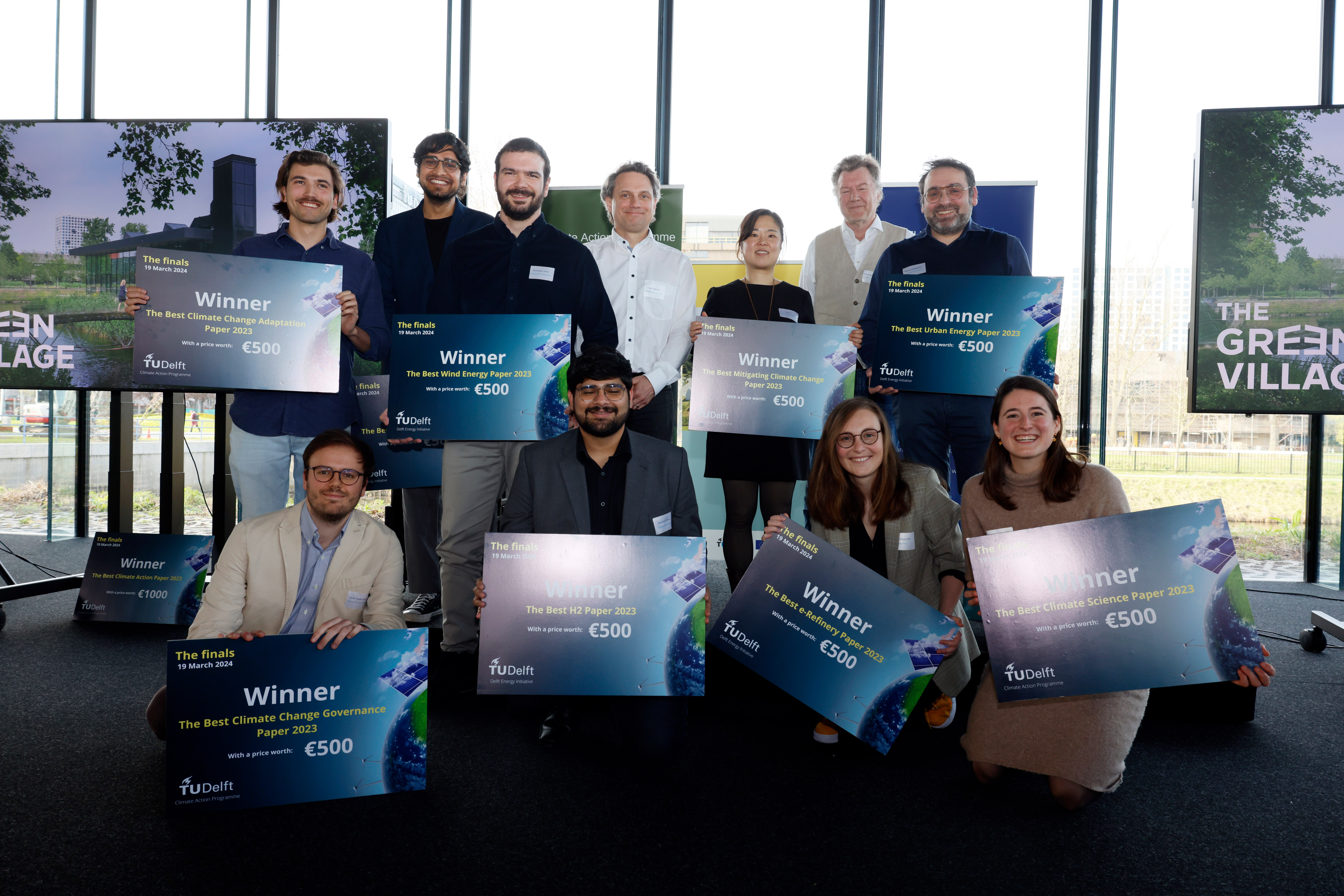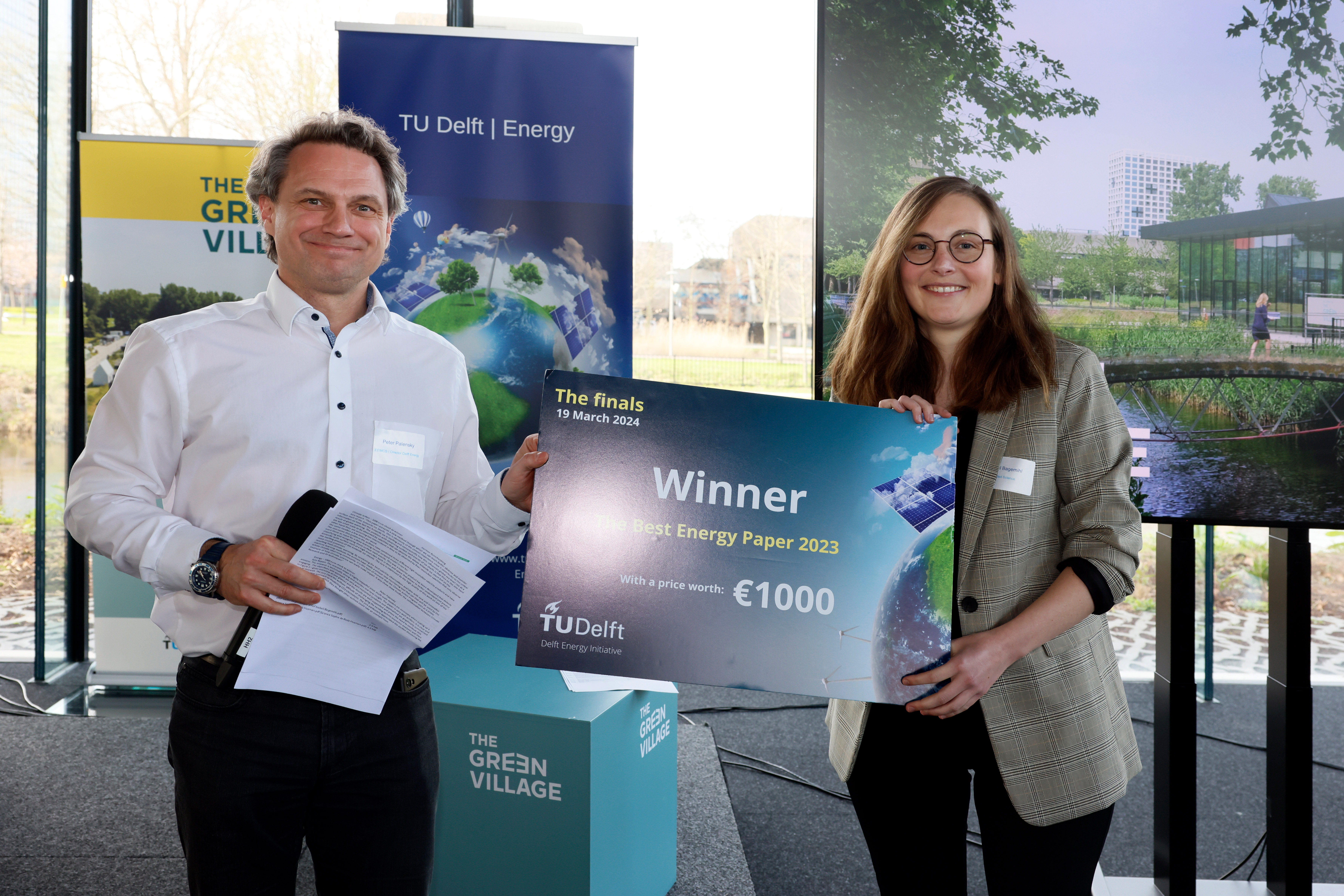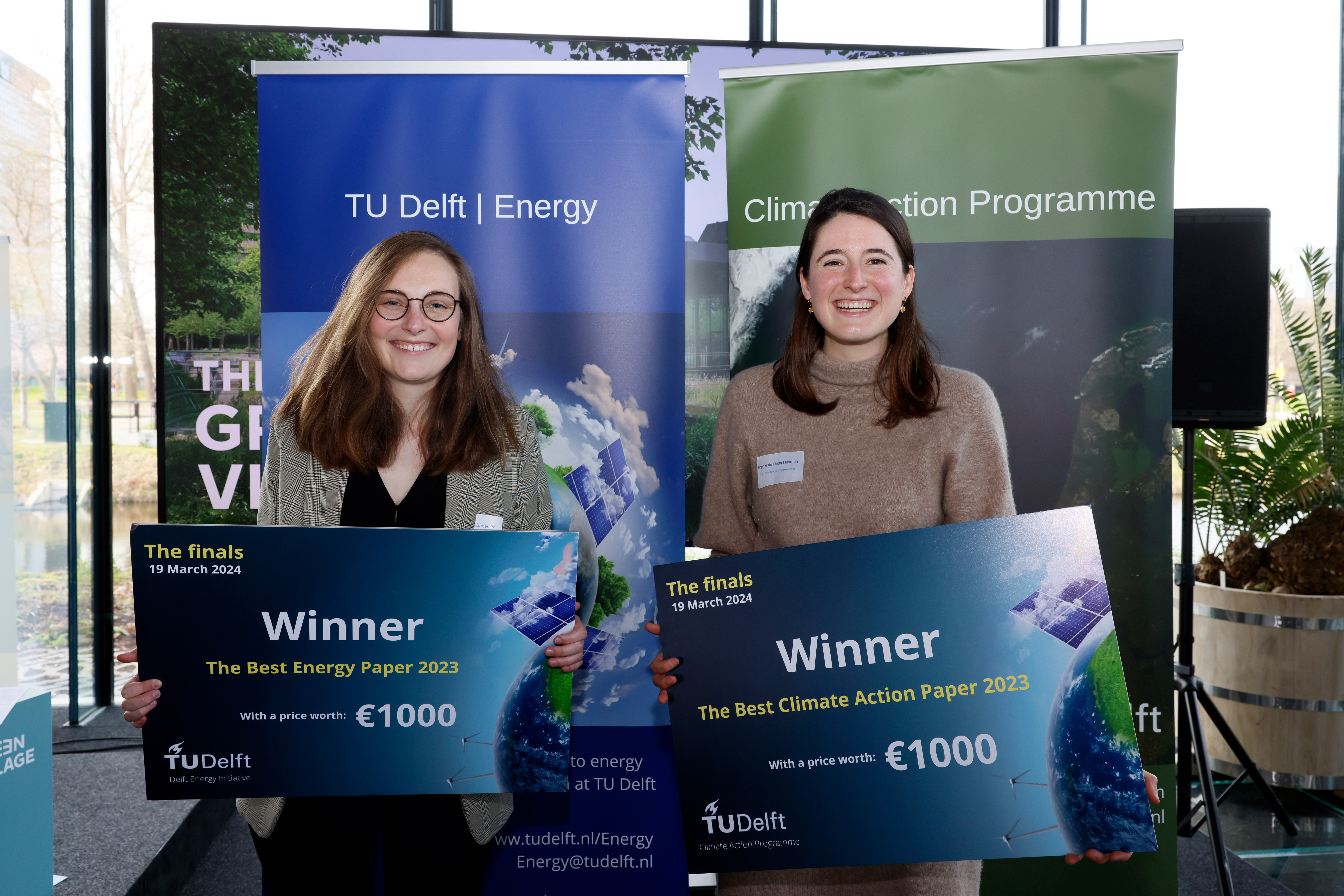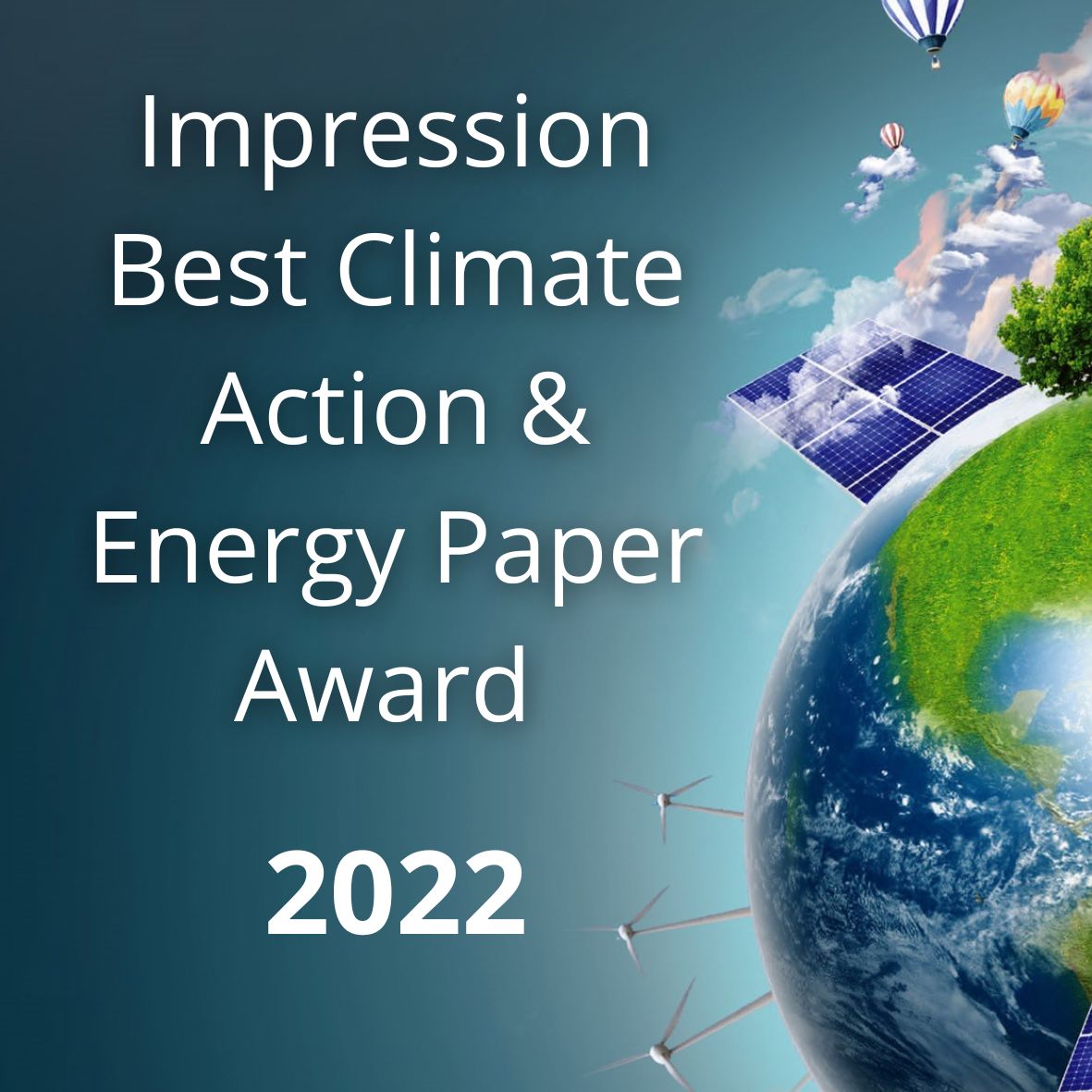Best Climate Action and Energy Paper 2023
Increasingly extreme weather conditions and a steadily rising sea level are unmistakable signs of the deepening climate crisis. Climate action and an accelerated energy transition can make a difference, with a crucial role for technology and engineering – and thereby for the thousands of students, PhDs, and postdocs of TU Delft.
9 Of these smart, young researcher were in the running for Best Climate Action & Energy Paper of 2023. These finalists, that were chosen out of 85 papers in total, pitched their research on Tuesday March 19th at the Green Village.
The overall jury announced the two winners: Isabell Bagemihl is finalist for the eRefinery Institute category and won the overall award for Energy. Sophie de Roda Husman, as finalist for the Climate Action Science theme won the overal award for Climate Action.
All 120 attendees on that day choose Sophie de Roda Husman, for the audience award!
Winners Best Climate Action & Energy Paper 2023
The giant awakens: a high-resolution record of Antarctic surface melting
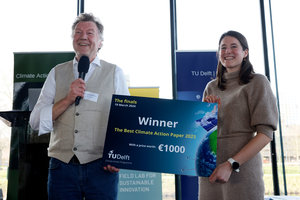 Antarctica has long been considered the “sleeping giant” of sea level rise, but it is poised to overtake Greenland as the main contributor by the end of this century. The devil is in the details when it comes to this contribution as ice shelf fragmentation is accelerated by multiple brief and very local melting events. And with satellite remote sensing data either having a high spatial resolution, or a high frequency in time, these often aren’t caught. Sophie de Roda Husman combined the gigantic datasets available to develop a Machine Learning model that overcomes these limitations. She subsequently created a historical record of Antarctic surface melt that is high-resolution in both space and time. Other scientists can use it to develop improved climate models and hydrological models that may reduce the uncertainty in modelled sea level rise by 2100 – also providing her Civil Engineering colleagues a better target for designing protective measures.
Antarctica has long been considered the “sleeping giant” of sea level rise, but it is poised to overtake Greenland as the main contributor by the end of this century. The devil is in the details when it comes to this contribution as ice shelf fragmentation is accelerated by multiple brief and very local melting events. And with satellite remote sensing data either having a high spatial resolution, or a high frequency in time, these often aren’t caught. Sophie de Roda Husman combined the gigantic datasets available to develop a Machine Learning model that overcomes these limitations. She subsequently created a historical record of Antarctic surface melt that is high-resolution in both space and time. Other scientists can use it to develop improved climate models and hydrological models that may reduce the uncertainty in modelled sea level rise by 2100 – also providing her Civil Engineering colleagues a better target for designing protective measures.
Sophie de Roda Husman, PhD (CEG). Winner of the Best Climate Action Paper 2023.
A high-resolution record of surface melt on Antarctic ice shelves using multi-source remote sensing data and deep learning
Read the paper here.
Closing the carbon cycle: from lab-scale to economic viability
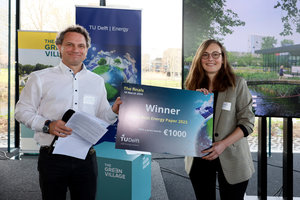 The burning, refining or processing of fossil fuels leads to CO2 emissions, thereby contributing to climate change. Low-temperature electrochemical conversion can do exactly the opposite: converting waste CO2 to much needed base and fine chemicals, thereby helping to make fossil fuels a thing of the past. This technology has already been demonstrated at lab-scale. But when it comes to assessing economic viability at factory-scale, techno-economic studies incorrectly assume that performance variables (such as energy efficiency or reaction product specificity) can be tuned independently of each other. Isabell Bagemihl developed a multi-scale model – from reaction channel to full-scale process – for assessing reactor design for electrochemical CO2 reduction from a techno-economic perspective. Specifically considering the performance interdependencies, it yields performance targets that are actually achievable in current electrolyser designs. She demonstrated her model for a single reaction (CO2 to ethylene) but it can be readily adapted to many more. Increasing the understanding from lab-scale to economic impact, her research may help guide future fundamental electrolyses research, bringing a closed carbon cycle ever closer.
The burning, refining or processing of fossil fuels leads to CO2 emissions, thereby contributing to climate change. Low-temperature electrochemical conversion can do exactly the opposite: converting waste CO2 to much needed base and fine chemicals, thereby helping to make fossil fuels a thing of the past. This technology has already been demonstrated at lab-scale. But when it comes to assessing economic viability at factory-scale, techno-economic studies incorrectly assume that performance variables (such as energy efficiency or reaction product specificity) can be tuned independently of each other. Isabell Bagemihl developed a multi-scale model – from reaction channel to full-scale process – for assessing reactor design for electrochemical CO2 reduction from a techno-economic perspective. Specifically considering the performance interdependencies, it yields performance targets that are actually achievable in current electrolyser designs. She demonstrated her model for a single reaction (CO2 to ethylene) but it can be readily adapted to many more. Increasing the understanding from lab-scale to economic impact, her research may help guide future fundamental electrolyses research, bringing a closed carbon cycle ever closer.
Isabell Bagemihl, PhD (AS). Winner of the Best Energy Paper 2023.
Techno-economic Assessment of CO2 Electrolysis: How Interdependencies between Model Variables Propagate Across Different Modelling Scales
Read the paper here.
Other Finalists Best Climate Action Paper 2023

Add biochar, potentially reduce landfill methane emissions
As the wastes in landfills biodegrade over time, the very potent greenhous gas methane is produced and released into the air. This accounts for about a third of global methane emissions. Susan Buisma-Yi investigated whether adding biochar (a byproduct of the pyrolysis process of biowaste) to the cover soil of landfills, as this can increase the capacity of microbes in this soil to reduce these methane emissions. The prevailing opinion is that enhancing soil porosity (more cavities in the soil) should increase such activity as it increases gas transport, thereby creating a favourable environment for these microbes. Her research, however, showed that these effects are highly soil specific, even though adding biochar increased porosity regardless of soil compaction. Although more research is needed to optimise the conditions, the potential to reduce methane emissions is there for some soil types. A double whammy as, in the Netherlands, biochar typically is not utilised but treated as waste.
Susan Buisma-Yi, PhD (CEG). Winner in the category Mitigating Climate Action.
Effects of fir-wood biochar on CH4 oxidation rates and methanotrophs in landfill cover soils packed at three different proctor compaction levels
Read the paper here.
 A closer look: the economic impact of sea level rise on European regions and sectors
A closer look: the economic impact of sea level rise on European regions and sectors
Economic impact assessments provide essential information for decision-makers in planning, allocating resources, and implementing strategies to address the challenges posed by sea level rise (SLR). But while adaptation is local, these assessments have predominantly been performed for entire countries or larger world regions. Using newly available data, Ignasi Cortés Arbués developed a much more fine-grained bottom-up approach for the EU + UK. It not only considers regional effects of SLR bus also economic relationships between various sectors. After all, flooding of a steel factory will have indirect economic impact beyond merely rebuilding it. Built on historical flooding data, the model is not meant for making future predictions or extracting precise policy recommendations. But it does exemplify that considering the local character of regions makes a big difference in economic downturn – or even upturn – after SLR-induced flooding. For example, while northern Italy may be hit hard, inland regions and other countries could benefit from increased trade. The article also suggests that targeted recovery expenditure to four critical sectors (Logistics, Public Services, Transport and Utilities) may substantially reduce GDP losses.
Ignasi Cortés Arbués, PhD (TPM). Winner of the category Climate Action Governance.
Distribution of economic damages due to climate‐driven sea‐level rise across European regions and sectors
Read the paper here.
 New horizons for nesting sea turtles
New horizons for nesting sea turtles
Having been around for 150 million years, accelerated climate change and human coastal activity threaten the nesting beaches of sea turtles – a key species in many local ecosystems. Jakob Christiaanse performed a comprehensive global-scale analysis of environmental influences on the distribution of sea turtle nesting habitats. He mapped 22 coastal indicators – such as sea surface temperature, tidal range, and coral reef and human proximity – onto a novel 50-km-resolution hexagonal coastline grid (called Coastgons). Relating these to known nesting grounds using machine learning, he identified influential indicators (favourable and not) for each sea turtle species. Most of these indicators had already been suggested in previous literature, but only based on a local analysis. Jakob’s global-scale analysis furthermore yielded new, potentially suitable nesting regions. His study may be a driver for nature-based solutions for restoring, preserving, and expanding sea turtles nesting habitats. Think of turtle-friendly sand nourishments or artificial reefs to provide protection from flooding and erosion.
Jakob Christiaanse, PhD (CEG). Winner in the category Climate Action Adaption.
Distribution of global sea turtle nesting explained from regional‐scale coastal characteristics
Read the paper here.
Other Finalists Best Energy Paper 2023
 A shady roof? There’s a solar panel that fits.
A shady roof? There’s a solar panel that fits.
The future of energy is in local production and consumption. But standard solar panels may see a big drop in performance even if only partially shaded, which can easily happen in urban areas. Andrés Calcabrini built a full-scale prototype solar panel that can dynamically reconfigure itself. Without shade, the panel will configure its solar cells in series for maximum output – like a long garden hose. But in shady conditions, when a single solar cell affects the output of the entire panel (like a garden hose bent at a sharp angle), it will switch to a more parallel arrangement. He subsequently tested this panel over a four-month period, exposing it to urban-like shading, to determine its year-round performance. While the additional electronics reduces power generation somewhat at moments without shade, it boosts the yearly energy yield with 10% compared to the current standard in “shade-resilient” panels. His study defines the limits for how much more expensive such a solar panel can be and whether it is worth mass-producing. Who knows, it may eventually pay off to put solar panels on your partially shaded garden shed, or any other partially shaded surface.
Andrés Calcabrini, PhD (EEMCS). Winner of the Urban Energy Institute.
Electrical performance of a fully reconfigurable series-parallel photovoltaic module
Read the paper here.
 Good vibrations: accelerating offshore wind energy
Good vibrations: accelerating offshore wind energy
Accelerating offshore wind energy deployment is essential for the energy transition. But the current technique for installing the monopile foundations – hammering – may not be up to the task while also raising alarming environmental concerns because of underwater noise pollution. Athanasios Tsetas helped develop a new pile driving technique. Much like you rotate a parasol pole when planting it on the beach, his technique adds torsional vibrations to vertical vibrations. With medium-scale experiments already successful, he now formulated the mathematical model that fully explains the underlying mechanics for the much larger piles that will drive the energy transition. Already closely collaborating with offshore contractors and developers, the next step is to perform bigger experiments to validate the model and the installation performance of the new technique. Then, it is only a matter of time for this socially and environmentally responsible technique to help bring wind energy into our homes.
Athanasios Tsetas, PhD (CEG). Winner of the Wind Energy Institute.
The mechanics of the Gentle Driving of Piles
Read the paper here.
 A zero-emission combustion cycle for decarbonizing the future energy grid
A zero-emission combustion cycle for decarbonizing the future energy grid
Although hydrogen fuel-cells demonstrate impressive efficiencies and emission-free operation, they are surpassed by gas turbines in power generation due to their superior operational characteristics, including high reliability, long service life, and low-cost operation and maintenance. The novel zero-emission HYCOS cycle holds the potential of combining these attributes. Capable of generating 10 to 50 MWs of on-demand power – which is equivalent to several wind turbines – it addresses a crucial gap in the distributed power generation market. Kaushal Dave analysed and optimized this cycle, achieving an impressive theoretical gas-to-power efficiency of over 55%. When integrated with hydrogen-based seasonal energy storage, the HYCOS cycle provides a compelling solution to mitigate renewable energy variability and enhance the flexibility of future distributed energy grids. It's not yet a slam-dunk, however, as the HYCOS cycle requires a combination of high temperature and high pressure, making component design a challenging task, particularly the recuperator. Nevertheless, it is perfectly poised to enable deep decarbonization of the future global economy.
Kaushal Dave, MSc (AE). Winner of the H2 Institute.
Thermodynamic analysis of a zero-emission combustion cycle for energy transition
Read the paper here.
 Location, location, location – finding faults in DC power grids
Location, location, location – finding faults in DC power grids
With the massive growth in renewable energy sources, such as wind and solar, demand for DC power grids (electricity grids using direct current) is expanding rapidly too. Although these systems are designed to function 24/7, electrical faults do occur. Having previously published on fault identification (which power line has a failure), Vaibhav Nougain has now developed a mathematical model that can pinpoint the location of the fault (where in this line is the failure) within milliseconds. This will save a lot of time and manual labour in locating and then fixing the fault, restoring normal DC power grid operation. Whereas previous research mostly focussed on locating the fault in a single line, Nougain’s breakthrough algorithm works no matter the complexity of the DC power system, or whether it is low, medium or high voltage. Applicable to ships, offshore wind energy, the two-way transfer of power in homes (and more), it is an essential tool for the transition towards renewable energy sources.
Vaibhav Nougain, PhD (EEMCS). Winner of the PowerWeb Institute.
Fault Location Algorithm for Multi-Terminal Radial Medium Voltage DC Microgrid
Read the paper here.
